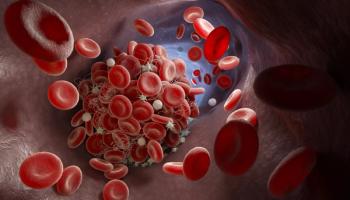
Jakafi Trial Shows Benefits for Patients with Myelofibrosis and Anemia

Key Takeaways
- Patients with myelofibrosis and anemia showed similar spleen size and symptom improvements as the overall JUMP study cohort when treated with ESAs or danazol and Jakafi.
- The JUMP trial, a phase 3b study, assessed Jakafi's safety and efficacy in real-world settings for myelofibrosis patients with anemia.
Supportive care with ESAs or danazol alongside Jakafi helps myelofibrosis patients with anemia manage symptoms and maintain effective treatment doses.
For patients with myelofibrosis who had anemia at diagnosis and received erythropoiesis-stimulating agents (ESAs) or danazol along with Jakafi (ruxolitinib), improvements in spleen size and symptom were similar to those seen in all participants of the JUMP study. Most patients were also able to tolerate daily Jakafi doses higher than 25 milligrams.
These results are based on study findings from the JUMP trial published in Clinical Lymphoma, Myeloma and Leukemia.
“These results reinforce using supportive care for anemia with an ESA or danazol combined with [Jakafi], which may allow [patients with myelofibrosis and anemia to] maintain their full Jakafi dose,” wrote lead study author, Dr. Pankit Vachhani, an associate professor at the University of Alabama at Birmingham.
Jakafi Study Shows Benefits for Myelofibrosis Patients with Anemia
The JUMP trial was a large phase 3b study evaluating the safety and effectiveness of Jakafi in real-world settings for adults with myelofibrosis. The study included 2,233 participants with either primary or secondary myelofibrosis and platelet counts of 50 billion per liter or higher.
This analysis focused on patients who had anemia at the start of the study, defined as hemoglobin levels below 12 g/dL, including a subset with levels below 10 g/dL. These patients were not receiving treatments for anemia at enrollment but started ESAs or danazol within three months and remained on treatment for at least three months. Researchers then assessed changes in spleen size and improvements in myelofibrosis-related symptoms.
Key Findings Show Improvements in Symptoms and Spleen
Among 1,343 patients with myelofibrosis and hemoglobin levels below 12 g/dL who were not receiving supportive care for anemia at the start of the study, 101 patients (7.5%) began treatment with either an ESA (98 patients) or danazol (3 patients) within three months of enrolling. Among the 732 patients with hemoglobin below 10 g/dL, 52 patients (7.1%) began one of these treatments during the same period.
In the group with hemoglobin below 12 g/dL, 91% had an enlarged spleen that could be felt by touch. The median time from enrollment to the first ESA or danazol dose was 43 days, ranging from 2 to 91 days. For those with hemoglobin below 10 12 g/dL, the median time from enrollment was 34 days, ranging from 2 to 90 days.
At week 24, reductions in spleen size were seen in 36.6% of patients in the group with hemoglobin below 12 time from enrollment and in 34.6% of those with hemoglobin below 10 time from enrollment, similar to the 31.5% reported in the overall study population. Symptom improvement rates were also comparable: 25.7%, 23.1%, and 26.9%, respectively.
For both groups, average hemoglobin levels dropped slightly by week 4 but then steadily rose above baseline levels by week 48. Most patients were able to maintain average daily doses of Jakafi above 25 mg throughout the study.
Understanding Myelofibrosis and Anemia
According to the National Cancer Institute, myelofibrosis is a disorder in which the bone marrow is replaced by fibrous tissue. As the marrow becomes scarred, blood cells are made in other organs such as the liver and spleen, often causing an enlarged spleen and progressive anemia that can lead to fatigue and other symptoms for patients.
Anemia occurs when the body has too few red blood cells to carry oxygen. It can cause fatigue, dizziness, shortness of breath and pale skin. In people with cancer, anemia may result from treatments like chemotherapy or radiation. Management includes rest, balanced activity, and healthy eating under medical guidance.
References
- “MPN-993: Clinical Outcomes in Patients With Myelofibrosis Treated With Ruxolitinib and Anemia-Supporting Medications,” by Dr. Pankit Vachhani, et al., Clinical Lymphoma, Myeloma and Leukemia.
- “Anemia: Cancer Treatment Side Effect,” by the National Cancer Institute. https://www.cancer.gov/about-cancer/treatment/side-effects/anemia
For more news on cancer updates, research and education,





